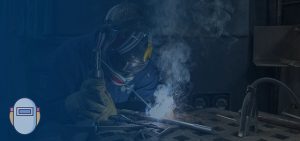Welding is one of the oldest ways to create one-piece joints of two or more metal parts.
The first welding methods arose at the origins of civilization.
To be precise, they appeared with the beginning of the use and processing of metals.
Manufacturing of metal products expanded in the occurrence of iron ores and non-ferrous metal ores.
In the old days, workers used welding of fusible metals like gold, copper, and tin.
Further, the development of technology and science led to the appearance of various types and methods.
Interestingly, during World War II, the welded turrets of the T-34 tank helped defeat Nazism.
Now welding is the most popular type of joining metals.
MIG or GMAW (Metal Inert Gas)
MIG is a universal type of welding.
The metal wire feeds automatically by the wire feed mechanism through the welding gun into the molten seam.
MIG differs in speed and absence of metal splashes.
It also produces a small volume of vapors and smoke.
Metal inert gas welding is good for any spatial provisions and various materials.
Almost all heavy industries use MIG as a universal welding method.
What is more, this method is one of the most convenient for home usage and does not require special skills.
TIG or GTAW (Tungsten Inert Gas)
TIG is welding with a special, non-consumable electrode in an inert atmosphere of shielding gas.
This is the most versatile type of welding.
It allows you to create permanent connections with various materials.
Notably, they are stainless steel, aluminum, bronze, brass, and other exotic metals.
The main advantages of TIG welding are the ability to make fine, almost jewelry works, and safe working conditions.
At the same time, low mobility, highly qualified employees and preliminary preparation of edges are among disadvantages.
SMAW or Stick Welding (Shielded Metal Arc Welding)
This process is also known as MMA welding.
SMAW uses a consumable electrode to support the arc of the weld.
In the same way, coating the external flow on the electrode is what acts as a screen when melted.
The core of the electrode becomes the actual placeholder when connecting the elements together.
SMAW is best suited for welds where the conditions around you and the metal itself are not the best.
As a result, this type of welding requires more practice.
FCAW (Flux Core)
FCAW is an automatic or semi-automatic welding process.
It uses a consumable electrode wire containing flux and a constant voltage to connect the metals together.
Sometimes it would also need an external shielding gas.
Logically, the flow is the most frequent, proper protection for the atmosphere.
FCAW process is the most popular in the construction due to its portability and high welding speed.
As with stick welding, windy conditions or a dirty, rusty metal are not so important when using flux-cored wire.
In other words, FCAW is double-shield welding because it uses a separate shielding gas.
Welds are also similar to those where it may take a long time to clean the welds after the end of the process.
Heavy-duty welding industries use FCAW more often than others.
This page is also available in Spanish.










